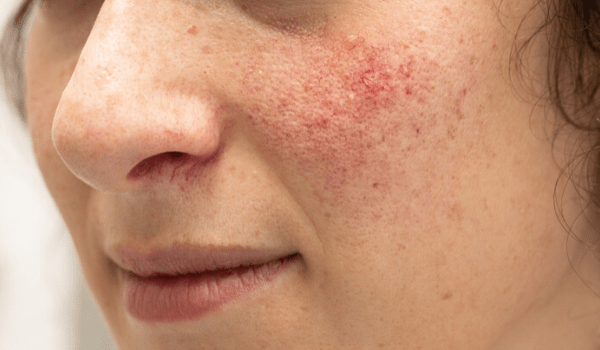What do W.C. Fields and Princess Diana have in common? They both had rosacea, a common skin condition that is often diagnosed in people who tend to flush or blush more easily than others. Anyone can have rosacea, but it is most common in middle-aged, light-skinned woman. There are many options for rosacea treatment, including laser skin treatment.
Rosacea causes redness in the cheeks and nose. The redness can spread to the forehead, chin, ears, chest, and back. Sometimes, rosacea produces small, red, pus-filled bumps that can often be confused for acne. Today, we’ll explore rosacea treatment, as well as common symptoms and causes of rosacea.
Rosacea Symptoms
While there is no test for rosacea, there are four primary symptoms of rosacea:
- Facial redness is the most common symptom of rosacea. Redness generally occurs in the central part of the face. Small blood vessels are usually visible on your nose and cheeks due to swelling.
- Swollen, red, pus-filled bumps, that resemble acne, can develop. Your skin may feel hot and tender.
- Eye problems, known as ocular rosacea, can occur. Those with rosacea often experience dry, irritated, swollen eyes and red, swollen eyelids. Eye symptoms may precede skin symptoms in some cases.
- Enlarged nose, known as rhinophyma, can also occur. Rosacea can cause the skin on the nose to thicken creating a bulbous shape. This is more common in men than women.
If you think you may have rosacea, it is important to see a board-certified dermatologist. Since there is no test for rosacea, your dermatologist will examine your skin and symptoms. They may also test for other conditions such as psoriasis, eczema, or lupus, which can all cause similar symptoms. After a diagnosis, your dermatologist will decide the best course of rosacea treatment for you.
Causes
While it is unclear what causes rosacea, it could be due to a combination of genetics and environmental factors. Rest assured that rosacea is not caused by poor hygiene.
Although the cause is unknown, there are certain factors that can trigger a flare-up, including:
- Hot drinks
- Spicy food
- Alcoholic beverages, specifically red wine
- Environmental factors like temperature extremes, sunlight, or wind
- Emotions
- Exercise
- Drugs that dilate blood vessels like certain blood pressure medications
- Various cosmetic products
Rosacea Treatment
Rosacea treatment focuses on controlling the symptoms and varies depending the severity of the condition. Most often, rosacea treatment is a combination of a healthy skin care routine and prescription drugs. Additionally, rosacea laser treatment can be used to successfully treat the redness associated with the condition. Here’s a more in-depth look at rosacea treatment:
Prescription Drugs
There is a variety of prescription drugs that can be prescribed to treat rosacea, including topical creams and gels, oral antibiotics, or oral acne drugs. The type of drug prescribed depends upon the severity and type of rosacea.
Topical creams for redness are applied to the affected skin and users can see results in as little as 12 hours. There are also topical creams that can be used to control the pimples from mild rosacea. Results take longer with theses creams, with noticeable improvements generally occurring in two to six weeks.
Oral antibiotics may be prescribed for moderate to severe rosacea with bumps and pimples. Oral acne drugs that help clear up the acne-like lesions of rosacea may be prescribed for severe rosacea that does not respond to other rosacea treatment.
Rosacea Laser Treatment
A laser therapy regimen may significantly help reduce the redness from rosacea. Laser therapy does not treat the pimples associated with rosacea. Typically three to four laser treatments at month intervals are required to effectively reduce the redness from rosacea.
When rosacea laser treatments are completed by trained professionals, they are safe procedures with mild side effects. The most common side effect is swelling at the treatment area, which usually occurs the day after treatment and can last five days. The physicians at Vujevich Dermatolgy Associates are the only trained professionals to operate our Excel V laser, which we use to treat rosacea. The board-certified dermatologists at Vujevich Dermatology Associates treat a variety of medical dermatology conditions.
Vujevich Dermatology Associates offers medical, surgical, and cosmetic dermatology from some of the most highly trained physicians and clinicians in the greater Pittsburgh area. You can reach our team at 412-429-2570 or visit our contact page to see all of our locations. You can also follow us on Facebook to see what’s new in the world of dermatology.

